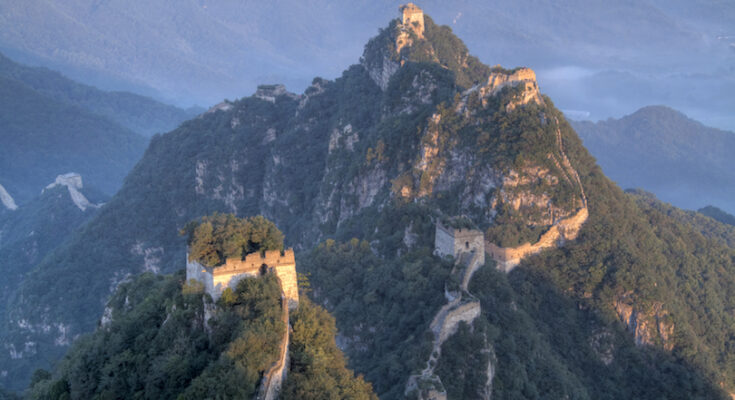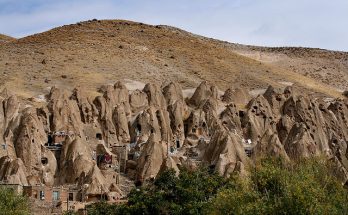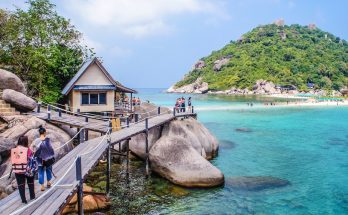Stretching for over 6,000 kilometers, the Great Wall of China is undoubtedly one of humankind’s most impressive architectural and engineering achievements. Over the centuries and millennia, various Chinese states and empires built sections of the wall to protect themselves from roving nomadic groups that threatened their territory from the north. As such, some parts date all the way back to the seventh century BC, while some of its most famous segments were only added in the 1500 and 1600s.
Snaking its way along mountain ridges through valleys and hills, the Great Wall stretches all the way from the Gobi Desert in the west to the Bohai Sea in the east and passes through 15 Chinese provinces along the way.
While many of its best-preserved and most impressive looking segments are to be found just outside Beijing, other more wild and remote, yet equally scenic parts are to be found further afield. As it is one of the most famous and iconic monuments in the world, no visit to China can ever be complete without taking a stroll along the Great Wall.
Known as the ‘Dragon’s Head,’ it is at Shanhaiguan that the Great Wall finally comes to an end and protrudes so dramatically into the Bohai Sea. Although the original part has long since crumbled into the waves, the wall has been fantastically rebuilt and restored, so you can snap photo after photo from atop of it of the sea smashing against it.
The old fortifications that surround the town of Qinhuangdao, where Shanhaiguan is located, are also considered to be part of the Great Wall and are well worth exploring if you have the time. Large segments are unrestored, and these offer up a possibly more authentic experience than the somewhat touristy Dragon’s Head. In addition to this, the town also boasts a brilliant museum that will teach you everything there is to know about the Great Wall and the people that once manned it.

Set amid some absolutely stunning scenery with beautiful mountains and valleys all around it, the Huangyaguan section of the Great Wall stretches some 40 kilometers and boasts lots of impressive towers and water gates. The latter are particularly interesting to visit, as the arches – which date to the 1400s – could be opened and closed depending on whether an enemy was approaching or not.
Although it is quite steep in a lot of places, the wall makes for some fabulous hiking. Every May, thousands of keen runners descend upon Huangyaguan to attempt its famous marathon. Considered by many to be almost like a miniature version of the Great Wall of China, Huangyaguan has lots of fascinating sights for you to see and explore, just in a condensed and more manageable area. Visiting Huangya Pass, for instance, is simply a must, and the view from atop of the Huangya Sky Ladder section is awe-inspiring.

As it lies just an hour and a half to the northeast of Beijing, Juyongguan has long played an important role in the defense of the nation’s capital. In Juyong Pass Fort, it boasts one of the Great Wall’s most impressive forts. Exhibiting wonderful architecture with some features dating back to the Ming Dynasty, the fort occupies a prominent position in the Guangou Valley – one of the most critical access points to Beijing.
Despite its air of impenetrability, the Juyongguan section of the wall was actually breached by Genghis Khan in both 1211 and 1213. As it is the closest section of the wall to Beijing, Juyongguan is a very popular draw among tourists, who come to hike along the top of it, visit its fabulous fort, and take snaps of the marvelous scenery.
Lying just a short distance away are the Dingling Tombs – the only Ming Dynasty imperial mausoleum to be opened – and its museum and underground palace are well worth visiting if you’re in the area.

Located around two hour’s drive from Beijing, Gubeikou is one of the wildest and most rewarding parts of the Great Wall to explore. Most of it is quite unrestored, with decaying battlements and crumbling ruins wherever you look. Strategically located along the back of the Yan Mountains, Gubeikou guarded an important pass to Beijing and remarkably saw over 130 battles take place along its wall.
It has a number of interesting monuments for you to check out, such as General Tower and 24-Eye Tower. Impressively enough, no renovations or constructions have taken place here since 1567. While it is not as popular as other parts of the Great Wall, Gubeikou is ideal if you’re looking for a quiet getaway; it has lots of scenic hikes and interesting historical attractions on offer.
Weaving its way along the rolling ridgeline of the Yan Mountains, the Simatai section of the Great Wall is renowned for the steep drops that plunge away to either side of it. It’s one of the only parts that you can see lit up at night. Hiking along the top of it makes for an exhilarating experience as it feels like you’re walking in the air. One part, the Sky Bridge, is only 40 centimeters wide.
Strung out along the wall are a series of watchtowers, with some of them lying just 50 meters apart. From these, you can enjoy some simply stupendous views. Besides hiking along the wall, visitors can also go zip-lining and take a boat trip on the nearby reservoir up to the East Tower. One of the most memorable things to do at Simatai is to take a nighttime stroll and amble peacefully along the Great Wall of China, which is stunningly lit up against the night sky.

Officially known as the ‘Lakeside Great Wall,’ Huanghuacheng is the only section to be built alongside a body of water, and some of it is actually immersed in the lake that lies at its foot. The beautiful blue Haoming Lake stands out delightfully against the forest-coated mountains that lie all around it, and the Great Wall meandering across the landscape only completes the perfect scene.
Due to the challenging terrain, this section of the wall took 180 years to complete, and much of it has not been restored since 1592. Named after the lovely little yellow wildflowers that dot the mountains around it in summer, Huanghuacheng is a tranquil part of the wall, with few visitors. As such, hiking here amid the beautiful scenery with barely another soul in sight is an amazing experience, and taking a boat ride on the lake to see the wall from below is simply a must.

Located some 70 kilometers to the north of Beijing, Jiankou is the wildest, most dangerous, and therefore most exhilarating part of the Great Wall to explore. Completed all the way back in 1368, the wall hasn’t been restored since. Much of it lies in disrepair, with plants, flowers, and trees found growing up from its crumbling bricks.
Jiankou is home to some of the steepest parts of the wall, with ‘Upward Flying Eagle’ and ‘Heavenly Ladder’ being particularly hair-raising to navigate. The mountain scenery on show is really is out of this world. While hiking along this wild yet breathtakingly beautiful part of the wall, many people choose to camp on its battlements. Another star attraction is the ‘Beijing Knot,’ which is the point where three different sections of the Great Wall of China come together.
Built in 1504, Badaling is one of the most well-restored parts of the Great Wall, and its proximity to Beijing makes it the most popular section to visit amongst tourists. As such, it gets very crowded and is undoubtedly the most touristy part of the wall by far, with lots of shops, restaurants, and even cable cars on offer.
Badaling still has its charms, however, and over the years, it has been visited by everyone from President Nixon to Queen Elizabeth II. Very pleasant to stroll along, its towering walls look out over some gorgeous scenery, with steep mountain slopes tumbling away to either side of it. For its ease of access and wealth of facilities and photo opportunities, Badaling is well worth visiting if you don’t have time to venture further afield.

As it is renowned for being one of the most beautiful sections of the wall, Jinshanling has long been a popular draw among hikers, who come to enjoy its pristine nature and stunning views. Located some 130 kilometers away from Beijing in Hebei province, the Jinshanling section of the Great Wall is wild in places and restored in others; this variety is, in part, what makes it so brilliant to hike.
Interspersed along its 10.5 kilometers are 67 watchtowers for you to check out; these feature a wide variety of different architectural styles. It usually takes around seven hours to hike from Jinshanling to Gubeikou or vice versa. The views of the Great Wall snaking its way off into the distance across mountain ridges, passes, and valleys is simply mesmerizing.

Despite its proximity to Beijing and its wealth of excellent views, Mutianyu is much less crowded than Badaling. As such, it is one of the most popular sections with foreign tourists. Surrounded on both sides by lush greenery, Mutianyu certainly makes for a fine sight as it cuts its way across the mountain ridges, with lots of watchtowers and fortresses dotted along the route.
To access the wall, visitors can either hike or take a cable car up to its battlements, and there is even a fun toboggan ride you can take to get down again. While it is still quite touristy in comparison with many other more remote sections of the wall, from time to time, you can still find yourself hiking along Mutianyu with barely another soul around. Boasting the longest, fully-restored section of the Great Wall of China, Mutianyu is a great place to start exploring all that this magnificent monument has to offer up.



